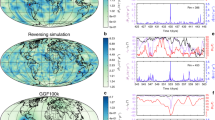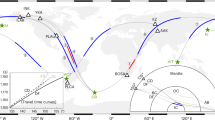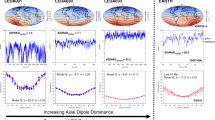Abstract
More than 20 years ago, on the basis of data from a Pacific sediment core, it was suggested that geomagnetic field intensity may vary with the Earth's orbital obliquity (centred on a period of ∼41 kyr) as a result of the effect of obliquity on precessional forces in the Earth's core1. It had also been proposed that precession plays an important role in the energy budget of the Earth's geodynamo2. But subsequent analyses indicated that the energy available from precession is at least an order of magnitude less than that required to drive the geodynamo3. Here, however, we report a spectral analysis of sedimentary records of relative geomagnetic palaeointensity from two North Atlantic sites which shows significant power both at orbital eccentricity (∼100 kyr) and obliquity (41 kyr). The eccentricity power is also present in bulk magnetic properties (such as susceptibility) and is therefore attributable to lithological variations controlled by eccentricity-driven climate change. The obliquity power, however, is not apparent in bulk magnetic properties, and seems to be a property of the geomagnetic field itself, thus providing evidence for the orbital forcing of geomagnetic field intensity.
This is a preview of subscription content, access via your institution
Access options
Subscribe to this journal
Receive 51 print issues and online access
$199.00 per year
only $3.90 per issue
Buy this article
- Purchase on Springer Link
- Instant access to full article PDF
Prices may be subject to local taxes which are calculated during checkout



Similar content being viewed by others
References
Kent, D. V. & Opdyke, N. Palaeomagnetic field intensity variations recorded in a Brunhes epoch deep-sea sediment core. Nature 266, 156–159 (1977).
Malkus, W. V. R. Precession of the Earth as a cause of geomagnetism. Science 160, 259–264 (1968).
Rochester, M. G., Jacobs, J. A., Smylie, D. E. & Chong, K. F. Can precession power the geomagnetic dynamo? Geophys. J. R. Astron. Soc. 43, 661–678 (1975).
Meynadier, L., Valet, J. P., Weeks, R., Shackleton, N. J. & Hagee, V. L. Relative geomagnetic intensity of the field during the last 140 ka. Earth Planet. Sci. Lett. 114, 39–57 (1992).
Tauxe, L. & Wu, G. Normalized remanence in sediments of the western equatorial Pacific, relative paleointensity of the geomagnetic field? J. Geophys. Res. 95, 12337–12350 (1990).
Tauxe, L. & Shackleton, N. J. Relative paleointensity records from the Ontong-Java plateau. Geophys. J. Int. 117, 769–782 (1994).
Tauxe, L. & Hartl, P. 11 million years of Oligocene geomagnetic field behaviour. Geophys. J. Int. 128, 217–229 (1997).
Shipboard Scientific Party. Site 983. Proc. ODP Init. Rep.162, 139–167 (1996).
Shipboard Scientific Party. Site 984. Proc. ODP Init. Rep.162, 169–222 (1996).
Hagelberg, T., Shackleton, N. J., Pisias, N. & Shipboard Scientific Party. Development of composite depth sections for Sites 844 through 854. Proc. ODP Init. Rep. 138, 79–85 (1992).
Tauxe, L. Sedimentary records of relative paleointensity of the geomagnetic field: theory and practice. Rev. Geophys. 31, 319–354 (1993).
Channell, J. E. T., Hodell, D. A. & Lehman, B. Relative geomagnetic paleointensity and δ18O at ODP Site 983 (Gardar Drift, North Atlantic) since 350 ka. Earth Planet. Sci. Lett. 153, 103–118 (1997).
Dunlop, D. J. Magnetic mineralogy of unheated and heated red sediments by coercivity spectrum analysis. Geophys. J. R. Astron. Soc. 27, 37–55 (1972).
Lowrie, W. Identification of ferromagnetic minerals in a rock by coercivity and unblocking temperature properties. Geophys. Res. Lett. 17, 159–162 (1990).
Day, R., Fuller, M. & Schmidt, V. A. Hysteresis properties of titanomagnetites: grain-size and compositional dependence. Phys. Earth Planet. Inter. 13, 260–267 (1977).
King, J. W., Banerjee, S. K. & Marvin, J. Anew rock-magnetic approach to selecting sediments for geomagnetic paleointensity studies: application to paleointensity for the last 4000 years. J. Geophys. Res. 88, 5911–5921 (1983).
Tauxe, L., LaBrecque, J. L., Dodson, R. & Fuller, M. U-channels — a new technique for paleomagnetic analysis of hydraulic piston cores. Eos 64, 219 (1983).
Weeks, R.et al. Improvements in long-core measurement techniques: applications in palaeomagnetism and palaeoceanography. Geophys. J. Int. 114, 651–662 (1993).
Stoner, J. S., Channell, J. E. T. & Hillaire-Marcel, C. Late Pleistocene relative geomagnetic paleointensity from the the deep Labrador Sea: regional and global correlations. Earth Planet. Sci. Lett. 134, 237–252 (1995).
Schneider, D. A. An estimate of late Pleistocene geomagnetic intensity variation from Sulu Sea sediments. Earth Planet. Sci. Lett. 120, 301–310 (1994).
Valet, J. P. & Meynadier, L. Geomagnetic field intensity and reversals during the past four million years. Nature 366, 234–238 (1993).
Martinson, D. G.et al. Age dating and the orbital theory of the Ice Ages: development of a high-resolution 0 to 300,000-year chronostratigraphy. Quat. Res. 27, 1–29 (1987).
Imbrie, J.et al. in Milankovitch and Climate (eds Berger, A. L., Imbrie, J., Hays, J., Kukla, G. & Saltzman, B.) 269–305 (NATO ASI Ser. 126, Riedel, Hingham, MA, (1984)).
Imbrie, J. & Imbrie, J. Z. Modeling the climate response to orbital variations. Science 207, 943–953 (1980).
Pisias, N. G., Mix, A. C. & Zahn, R. Nonlinear response in the global climate system: evidence from benthic oxygen isotopic record in Core RC13-110. Paleoceanography 5, 147–160 (1990).
Shackleton, N. J., Berger, A. & Peltier, W. R. An alternative astronomical calibration of the lower Pleistocene timescale based on ODP Site 677. Trans. R. Soc. Edinb. Earth Sci. 81, 251–261 (1990).
Vidal, L.et al. Evidence for changes in the North Atlantic deep water linked to meltwater surges during the Heinrich events. Earth Planet. Sci. Lett. 146, 13–27 (1997).
Berger, A. Long-term variations of daily insolation and Quaternary climatic change. J. Atmos. Sci. 35, 2362–2367 (1978).
Berger, A. & Loutre, M. F. Insolation values for the climate of the last 10 million years. Quat. Sci. Rev. 10, 297–317 (1991).
Paillard, D., Labeyrie, L. & Yiou, P. Macintosh program performs time-series analysis. Eos 77, 379 (1996).
Blackman, R. B. & Tukey, J. W. The Measurement of Power Spectra from the Point of View of Communication Engineering (Dover, New York, (1958)).
Jenkins, G. M. & Watts, D. G. Spectral Analysis and its Applications (Holden-Day, Oakland, CA, (1968)).
Acknowledgements
We thank C. Laj, C. Kissel and A. Mazaud for logistic support and discussions; and J.S. Stoner and J. D. Ortiz for comments on the manuscript. The paleomagnetic laboratory at Gif-sur-Yvette is supported by CEA and CNRS. At the University of Florida, this project was supported by the US Science Support Program.
Author information
Authors and Affiliations
Corresponding author
Rights and permissions
About this article
Cite this article
Channell, J., Hodell, D., McManus, J. et al. Orbital modulation of the Earth's magnetic field intensity. Nature 394, 464–468 (1998). https://doi.org/10.1038/28833
Received:
Accepted:
Issue Date:
DOI: https://doi.org/10.1038/28833
This article is cited by
-
Statistical analysis of the connection between geomagnetic field reversal, a supernova, and climate change during the Plio–Pleistocene transition
International Journal of Earth Sciences (2022)
-
Long-term projection of future climate change over the twenty-first century in the Sahara region in Africa under four Shared Socio-Economic Pathways scenarios
Environmental Science and Pollution Research (2022)
-
Paleomagnetic direction and paleointensity variations during the Matuyama–Brunhes polarity transition from a marine succession in the Chiba composite section of the Boso Peninsula, central Japan
Earth, Planets and Space (2017)
-
Paleomagnetic directions of the Gauss-Matuyama polarity transition recorded in drift sediments (IODP Site U1314) in the North Atlantic
Earth, Planets and Space (2008)
-
A relative paleointensity record of the geomagnetic field since 1.6 Ma from the North Pacific
Earth, Planets and Space (2007)
Comments
By submitting a comment you agree to abide by our Terms and Community Guidelines. If you find something abusive or that does not comply with our terms or guidelines please flag it as inappropriate.




